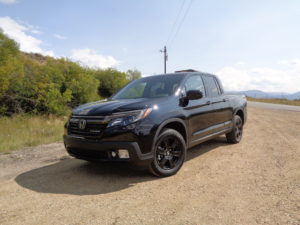
By Bud Wells
Honda’s pickup, out of production the past two years, is back in renewed style.
The 2017 Ridgeline, unibody-constructed, is more carlike than competitive makes, though it falls short in tow capacity and offroad capabilities.
That suits lots of Honda buyers. They wouldn’t be “caught dead” in a traditional, tough truck, though they’re livening up the showroom in a beeline rush around the refined Ridgeline.
With Davis Adams, Honda PR regional manager, as my passenger, I drove the new Ridgeline at Devil’s Thumb Ranch in the mountains near Tabernash for half-an-hour on an afternoon in September. Then, earlier in October, I had opportunity to drive the same ’17 model for a week.
It was the high-end Ridgeline Black Edition with all-wheel drive, black leather interior and 18-inch black alloy wheels – a dark color scheme dominant both outside and in.
The returning Honda pickup has increased size, 30 more horsepower and shows improved exterior appeal. It is 4 inches longer overall than previously and 3.3 inches longer in wheelbase. Its cargo bed is 3.9 inches longer and 5.5 inches wider. It is front-wheel-drive based; most others in its class are of rear-wheel base.
The new smooth performance is provided by the Honda’s 280-horsepower, 3.5-liter V-6 engine and 6-speed automatic transmission (262 lb.-ft. of torque). Its intelligent Traction Management system permits switching of driving modes to better accommodate maneuvers in snow, mud or sand. It rides on Firestone Destination 245/60R18 tires.
In terms of tow capacity, the new Ridgeline trails the competition. Equipped with all-wheel drive, the Ridgeline will tow up to 5,000 pounds. The GMC Canyon and Chevy Colorado, when properly equipped will tow up to 7,700 pounds, the Toyota Tacoma up to 6,800 and the aged Nissan Frontier up to 6,500.
The Ridgeline surely is a delight for athletic-event tailgaters. The pickup’s tailgate drops normal-style or swings open from the side, lending access to the huge storage tub (Honda calls it a trunk) with drain plug for beverages and ice beneath the floor of the pickup bed.
The Honda’s new audio system includes six “exciters” inside the bed walls, producing sound from the truck’s audio head unit. Exciters turn solid objects into speakers with extremely high-speed vibrations. Any audio heard in the cab also sounds in the bed. Added to the bed, too, is an available 400-watt power inverter for recharging power tools.
Overall fuel-mileage average was 19.7, though it is rated higher at 19/26 miles per gallon.
Loaded with equipment, including the premium audio setup/Pandora/Bluetooth/voice-recognition navigation and multiview rear camera, the Ridgeline carried a $43,770 sticker price. Other amenities are heated leather seats and heated steering wheel, power moonroof, trizone automatic climate control, automatic high beams, blind-spot alert and cross-traffic monitor, lane-keeping assist and remote engine start.
The Honda Ridgeline is built in Lincoln, Ala. Seventy-five percent of its parts are produced in the U.S. or Canada.
Honda is the fifth-best-selling brand in Colorado, just ahead of Jeep. Company officials are counting on the Ridgeline to help maintain that position.
Toyota, Ford and Subaru are top three brand sellers in Colorado through the first eight months of this year. Sales totals in Colorado by brand:
- Toyota 18,315
- Ford 15,320
- Subaru 14,993
- Chevrolet 10,036
- Honda 9,400
- Jeep 9,174
- Nissan 7,391
- Ram 5,165
- GMC 4,213
- Hyundai 4,085
- Volkswagen 3,220
- Kia 3,158
- Mazda 2,850
- BMW 2,668
- Lexus 2,548
- Audi 2,446
- Dodge 2,364
- Mercedes-Benz 2,037
- Buick 1,205
- Acura 1,179
- Volvo 841
- Infiniti 840
- Chrysler 799
- Cadillac 754
- Mitsubishi 674
- Land Rover 670
- Mini 601
- Lincoln 587
- Porsche 506
- Tesla 429
- Fiat 208
- Jaguar 101
- Maserati 48
- smart 39


